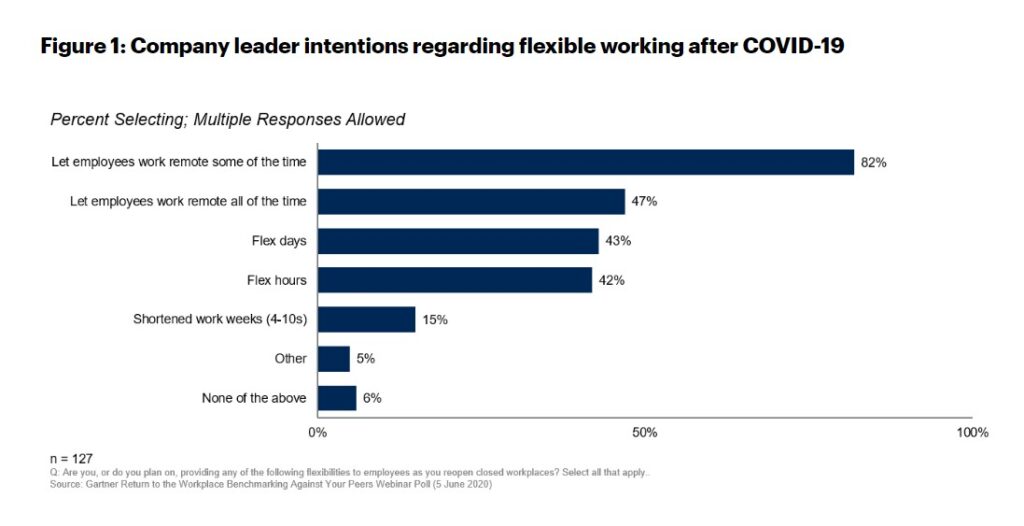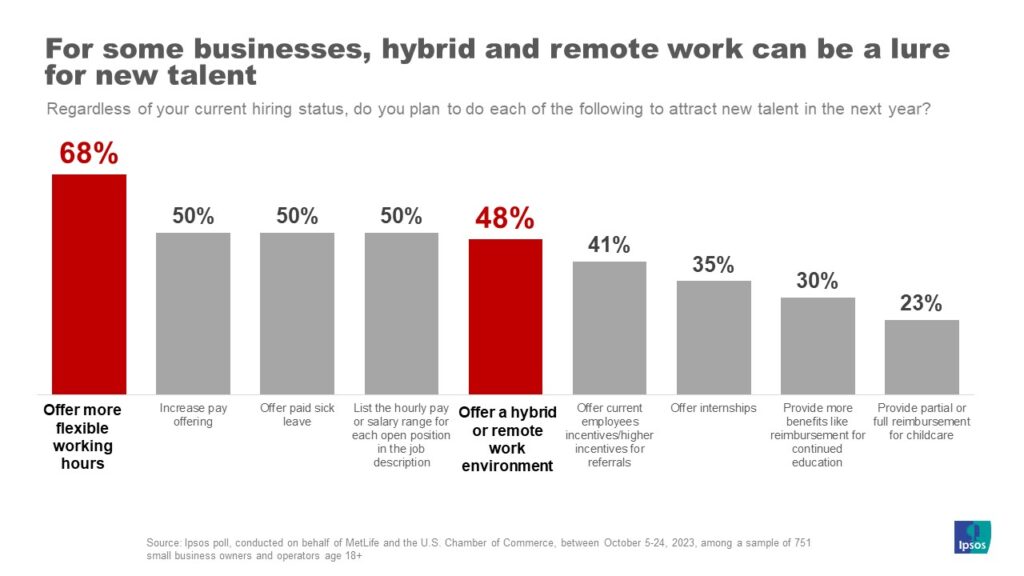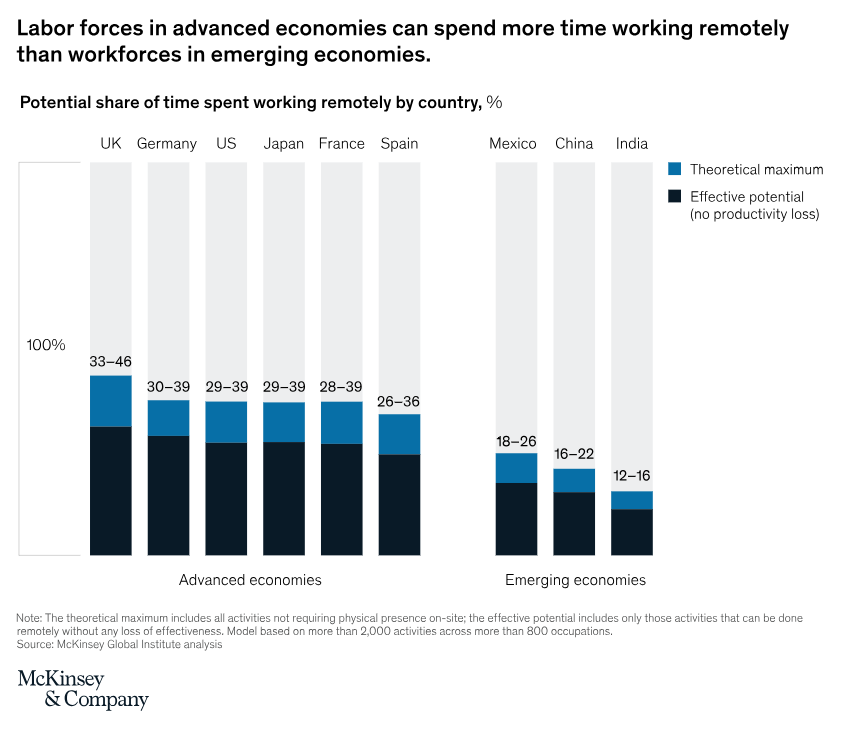Worksploring – Inside the Numbers

Remote work, a once-niche employment model, has surged into the mainstream, driven by advancements in technology and catalyzed by the COVID-19 pandemic. This paradigm shift has brought significant benefits to both employees and employers while also highlighting meaningful trends that are reshaping the future of work. Make no mistake, remote work is an important and valuable business input that impacts a number of key metrics, including revenue.
Increased Flexibility – For employees, one of the most significant benefits of remote work is increased flexibility. According to a survey by FlexJobs, 65% of respondents reported a preference for full-time remote work post-pandemic. This flexibility allows employees to better balance their work and personal lives, leading to improved mental health and reduced stress. The American Psychological Association noted that workers with flexible schedules reported lower levels of stress and burnout, which can translate into higher job satisfaction and productivity.
Mental and Physical Health Benefits – Remote work positively impacts employees’ mental and physical health. Nearly all surveyed professionals agreed that working from home is beneficial for their health, with 93% noting improvements in mental health and 90% in physical health. The primary health benefit cited was decreased stress, reported by 48% of respondents. Additional benefits include reduced burnout and healthier eating habits.
Stress Reduction – Remote workers experience lower stress levels compared to their in-office counterparts. Only 36% of remote workers reported increased stress over the past year, compared to 55% of hybrid workers and 59% of in-office employees. This lower stress level is likely due to the flexibility and autonomy that remote work provides.
Remote work’s flexibility allows employees to engage in activities that improve their well-being. A survey found that 72% of remote employees want the ability to nap or exercise during the workday, and 73% wish to watch TV while working. This flexibility during slower parts of the workday contributes to higher job satisfaction and overall productivity.

Employer Benefits – Remote work is financially advantageous for employers. Companies can save up to $10,600 per employee annually by reducing expenses related to office space, utilities, and supplies. A company with 50 employees could save half a million dollars each year by adopting a remote work model. These savings stem from reduced need for office space, lower utility costs, and decreased expenses related to office supplies and amenities. Additionally, remote work can lead to lower turnover rates. Owl Labs’ 2020 State of Remote Work report found that companies supporting remote work have 25% lower employee turnover than those that do not, as employees who have the option to work remotely tend to be more satisfied and loyal. Employees also benefit financially. A fully remote worker can save up to $12,000 per year on costs such as transportation, professional attire, and meals. Hybrid workers, who split their time between home and the office, can save approximately $6,000 annually. These savings are substantial, particularly in times of economic uncertainty.
Talent Impact– Remote work also broadens the talent pool for employers. Without geographic constraints, companies can hire the best talent from anywhere in the world, increasing diversity and bringing in a variety of perspectives and skills. This has been particularly beneficial in the tech industry, where there is a high demand for specialized skills. Companies like GitLab, which operate entirely remotely, have leveraged this advantage to build a globally distributed workforce, ensuring they can find and retain top talent regardless of location.

Companies are increasingly using flexible work arrangements to attract and retain talent. Strategies include permitting hybrid work, creating remote work guidelines, and hiring talent from broader geographic areas. In 2024, the top retention strategies will likely focus on allowing flexible schedules and hybrid work options.
Younger workers, particularly those aged 20-24, are less likely to apply for remote roles, possibly due to a preference for social interaction at work. Millennials account for the highest proportion of remote workers, making up 36.5% of remote employees. Geographically, Colorado has the highest percentage of remote workers, with 37.34% working from home at least one day per week, while Mississippi has the lowest, at 11.93%.
Remote work trends vary across different demographics. More male employees work from home than female employees, with 49.6% identifying as male and 46.4% as female. The racial composition of remote workers shows that nearly two-thirds are white, followed by Hispanic/Latino, black, and Asian employees. Younger workers, particularly those aged 20-24, are less likely to apply for remote roles, possibly due to a preference for social interaction at work.
Flexible working conditions are particularly beneficial for women, helping them balance work and personal responsibilities. Women in remote or hybrid roles report less fatigue and burnout, and greater job satisfaction. However, female remote workers are twice as likely to stay in a job but be less happy if required to work in the office full-time compared to their male counterparts.
Remote work has been shown to improve workplace culture for marginalized groups. In Australia, 51% of workers from marginalized backgrounds reported an improvement in workplace culture when working remotely. Additionally, remote work can protect against workplace discrimination, with 66% of marginalized workers stating it shields them from such issues.
However, the shift to remote work is not without its challenges and trends that require attention. One notable trend is the increasing importance of digital infrastructure and cybersecurity. As employees access company resources from various locations, the risk of cyber threats increases. A report by Upwork highlighted that 61% of companies plan to invest more in cybersecurity measures for their remote teams, recognizing the critical need to protect sensitive information.
Positive Impact on Organizational Culture – Flexible work models have been reported to positively affect organizational culture, with 60% of executives in 2023 noting this improvement, up from 39% in the previous year. Smaller firms, in particular, benefit from the adaptability and relative flexibility offered by remote work.

Commuting Efficiency – Remote work also reduces commuting time, which has substantial implications for employee well-being and productivity. The U.S. Census Bureau reports that the average one-way commute time in the United States is 27.6 minutes. Eliminating this daily commute saves employees over nine full days each year, time that can be reallocated to personal activities, rest, or additional work. While in the United States, remote workers save an average of 55 minutes per day by eliminating their commute, global savings are higher at 72 minutes. These time savings have profound implications for productivity, personal well-being, and environmental sustainability. Research indicates that 40% of remote workers use the time saved from commuting to focus on their primary or secondary jobs, leading to substantial gains in work output. Employees can start their workday earlier or extend it without the stress of travel.
Environmental Impact – Remote work significantly reduces greenhouse gas emissions. By not commuting five days a week, remote workers can cut their carbon footprint by up to 54%. Even working from home one day a week can reduce emissions by 2%, with two to four days yielding a reduction of up to 29%. These figures underscore the potential of remote work to contribute to environmental sustainability on a large scale.
Productivity and Trust – Productivity is another area where employers see gains. Contrary to the early fears that remote work would lead to decreased productivity, studies have shown the opposite. A Stanford study revealed that remote workers are 13% more productive than their in-office counterparts. This productivity boost is attributed to fewer distractions, more efficient time management, and a quieter, personalized work environment. Employers also see benefits in remote work. 79% of managers believe their teams are more productive when working remotely. However, trust varies, with 79% of fully remote workers feeling trusted by their managers, compared to 64% of hybrid workers. While 56% of hiring managers report that remote work has gone better than expected, 9% found it worse than anticipated. Remote work has been associated with increased productivity, with 62% of workers feeling more productive when working remotely.

Office Occupancy and Space Utilization – As of April 2024, office occupancy in the U.S. averages 48% weekly, indicating a significant return to office spaces . However, this does not signify a complete shift back to traditional work models but rather a hybrid approach that balances remote and in-office work.
Policies and a trend towards Hybrid – Another trend is the evolving nature of remote work policies. Hybrid models, where employees split their time between remote and office work, are becoming more common. According to PwC’s U.S. Remote Work Survey, 72% of executives plan to adopt a hybrid work model. This approach aims to combine the benefits of remote work with the collaborative advantages of in-person interactions.
Hybrid Work Patterns – On average, hybrid employees globally go into the office two to three days a week. Specifically, 36% work in the office two days a week, while 34% do so three days a week. Despite this, 54% of workers are currently working from the office full-time, though only 19% desire this arrangement.
Remote Work and Job Changes – Employee mobility has also been significant, with 17% of employees changing companies in 2023 and 29% doing so in 2022 . A notable 40% of workers reported an increase in work-related stress over the past year.
A substantial proportion of employees (66%) believe that working from home should be a legal right, excluding the U.S. context. If remote work flexibility were removed, 66% of employees would seek new jobs, and 39% would quit immediately . Interestingly, 45% of employees think their employers are unlikely to change remote or hybrid work policies in the next year.

Technology – The role of technology in remote work is expanding. Tools for virtual collaboration, project management, and communication have seen rapid development and adoption. Companies like Zoom, Slack, and Microsoft Teams have become integral to maintaining productivity and connectivity in a remote work environment. The increased reliance on these tools has also led to innovations in virtual reality (VR) and augmented reality (AR), aimed at enhancing remote collaboration experiences.
Up-skilling – The cultural shift towards remote work has also emphasized the need for continuous learning and development. With remote work, employees must adapt to new technologies and workflows, necessitating ongoing training and skill development. LinkedIn’s Workplace Learning Report 2020 found a 130% increase in online learning engagement, underscoring the growing importance of professional development in a remote work setting.
Preference for Remote Work – The overwhelming majority of workers express a preference for remote work. Over 95% desire some form of remote work, with 54% wanting fully remote roles and 41% favoring a hybrid model. Remote work’s importance surpasses even salary for many employees, highlighting its value in job satisfaction and work-life balance.

The shift towards remote and hybrid work is evident, with a significant number of employees favoring these flexible work models over traditional in-office roles. In 2022, the number of workers choosing remote work increased by 24%, while those opting for hybrid work rose by 16%. Conversely, interest in full-time in-office work declined by 24%.
Remote work is here – As remote work continues to evolve, it will become an integral part of the modern workplace, reshaping how and where work is done. The rise of remote work offers extensive benefits in terms of time savings, financial advantages, environmental impact, and improved health and well-being.
Make no mistake, remote work is an important and valuable business input that impacts a number of key metrics, including revenue.
Engage with a Remote Work Specialist today.
*This article was put together with a lot of information and the assistance of ai. Not all sources may be referenced, and it may include some errors.
Footnotes and additional statistics
According to the Pew Research Center, around 22 million employed adults (aged 18 and over) in the U.S. work from home all the time, equal to roughly 14% of all employed adults.
Just over one-third of workers in the U.S. who can work remotely do so all the time — while 41% are at least part-time remote on a hybrid setup.
More than one in five Americans will work remotely by 2025.
According to a survey we conducted, 58% of white-collar workers prefer to work remotely at least three days a week.
Only 16% of white-collar workers would consider a role that doesn’t offer any days of remote work.
42% of office workers would take a 10% pay cut to have the flexibility to work remotely.
According to Upwork’s Future of Remote Work study, one-third of hiring managers said that productivity has increased due to remote work settings.
98% of remote workers would work remotely for the rest of their careers and recommend remote work to others.
66% of respondents worldwide believe that working from home should be a legal right.
29% of hybrid and remote workers would expect a pay rise if they were forced to go back to the office full-time.
If their flexibility to work remotely were taken off the table, 1 in 3 workers (31%) would start to look for a new job and 6% would quit.
Over 90% of employees believe they are as productive or more productive in their work model than they were the previous year.
65% of companies offer some work flexibility in 2024, which is a 14% increase from 2023.
75% of remote workers said their companies help them connect with colleagues for work.
40% of people wouldn’t take a job that doesn’t offer flexible work hours or requires them to be present in the office during specific days or times.
16% of employees would take a 20% pay cut to get flexible work hours, and 17% of respondents would take the same pay cut to work remotely.
53% of employees don’t trust that the company policies they had in 2023 will remain in place in 2024.
#worksploring #theworldisyouroffice #escapethecubicle
USA Today Blueprint – Remote working statistics survey (conducted by OnePoll).
Upwork – Upwork Study Finds 22% of American Workforce Will Be Remote by 2025.
Upwork – The Future of Remote Work.
Pew Research Center – About a third of U.S. workers who can work from home now do so all the time.
U.S. Census Bureau – DP03 Selected Economic Characteristics.
McKinsey & Company – Americans are embracing flexible work—and they want more of it.
Owl Labs – State of Hybrid Work 2023.
Quantum Workplace – The State of Remote Work.
Resume Builder – 90% of Companies Will Return to Office By the End of 2024.
Gallup – The Future of the Office Has Arrived: It’s Hybrid.
Flex Index – The Flex Report.
FlexJobs – Losing Talent to Return-to-Office Mandates: Insights From the FlexJobs Survey.
FlexJobs – Remote Work Statistics & Trends: The Latest in Remote Work.
FlexJobs – Exploring the Impact of Remote Work on Mental Health and the Workplace.
Pumple – https://pumble.com/learn/collaboration/remote-work-statistics/
USA Today https://www.usatoday.com/money/blueprint/business/hr-payroll/remote-work-statistics/
Recommend0 recommendationsPublished in Blog, Insights, Uncategorized

